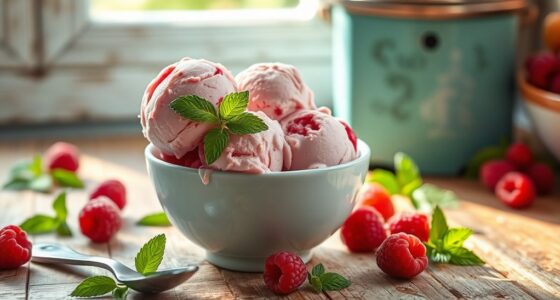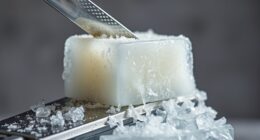Edible flower toppings bring vibrant colors and unique flavors to your dishes, making meals visually appealing and delicious. Flowers like nasturtiums, pansies, and violets add a touch of beauty and taste to your salads, desserts, and soups. To prepare, rinse the flowers, marinate them in a honey mixture, and garnish your creations attractively. Fresh, seasonal flowers enhance both flavor and presentation. Discover more tips and recipes to elevate your culinary experience.
Key Takeaways
- Edible flowers like nasturtiums, pansies, and violets add both flavor and visual appeal to dishes.
- Freshness is key; choose vibrant, firm petals free from chemicals for the best taste.
- Rinse and dry flowers gently, removing stems and leaves to use only the petals.
- Marinate flowers in a honey mixture to enhance their flavors before adding to your dishes.
- Use flowers artistically as garnishes for soups, salads, and desserts to impress guests.
History
Edible flowers have a rich history that dates back thousands of years, as cultures around the world have embraced these vibrant botanicals for both culinary and medicinal uses.
You might be surprised to learn that ancient Egyptians used flowers like marigolds and violets in their food, believing they added flavor and beauty. In China, flower petals were often incorporated into dishes to enhance taste and symbolize prosperity.
The Romans also valued edible flowers, using them in salads and desserts. As you explore different cuisines, you’ll find that edible flowers continue to play an essential role in enhancing dishes, providing not just flavor but also visual appeal.
Edible flowers have been cherished since Roman times, adding flavor and beauty to salads and desserts alike.
Their historical significance reflects humanity’s long-standing appreciation for nature’s beauty and bounty.
Recipe
Edible flower toppings are a delightful way to elevate your dishes, adding not only a splash of color but also unique flavors that can enhance any meal.
Whether you’re looking to beautify a salad, cake, or even a savory dish, incorporating edible flowers can impress your guests and make your culinary creations stand out. This recipe will guide you through preparing a vibrant edible flower topping that can be used in a variety of ways.
To start, you’ll need a selection of fresh edible flowers, which can be sourced from local markets or your own garden if you grow them organically. Common choices include nasturtiums, pansies, and violets, all of which aren’t only beautiful but also edible.
The key to this recipe is to choose flowers that aren’t only visually appealing but also complement the flavors of your dish.
Ingredients:
- 1 cup mixed edible flowers (such as nasturtiums, pansies, and violets)
- 2 tablespoons honey or agave syrup
- 1 tablespoon lemon juice
- 1 tablespoon water
- 1 teaspoon vanilla extract
Instructions:
In a small bowl, combine the honey (or agave syrup), lemon juice, water, and vanilla extract, stirring until well mixed.
Gently rinse the edible flowers under cold water to remove any dirt or insects, then pat them dry with a paper towel.
In a separate bowl, toss the flowers with the honey mixture, making sure they’re well coated. Allow the flowers to marinate for about 30 minutes to enhance their flavor before using them as a topping on your desired dish.
Extra Tips:
When preparing edible flower toppings, it’s important to choose flowers that are pesticide-free. If you’re foraging from your garden, verify that no chemicals have been used.
Additionally, always taste a small petal before using a flower to familiarize yourself with its flavor, as some can be surprisingly bitter or strong.
Feel free to experiment with different flower combinations to find the perfect match for your dishes!
Cooking Steps
To start using edible flowers, you’ll want to prepare your selection carefully.
Rinse and pat them dry, then remove any stems and leaves that aren’t needed.
Once you’re ready, arrange the flowers aesthetically to create a beautiful garnish for your dish.
Step 1. Prepare Edible Flower Selection
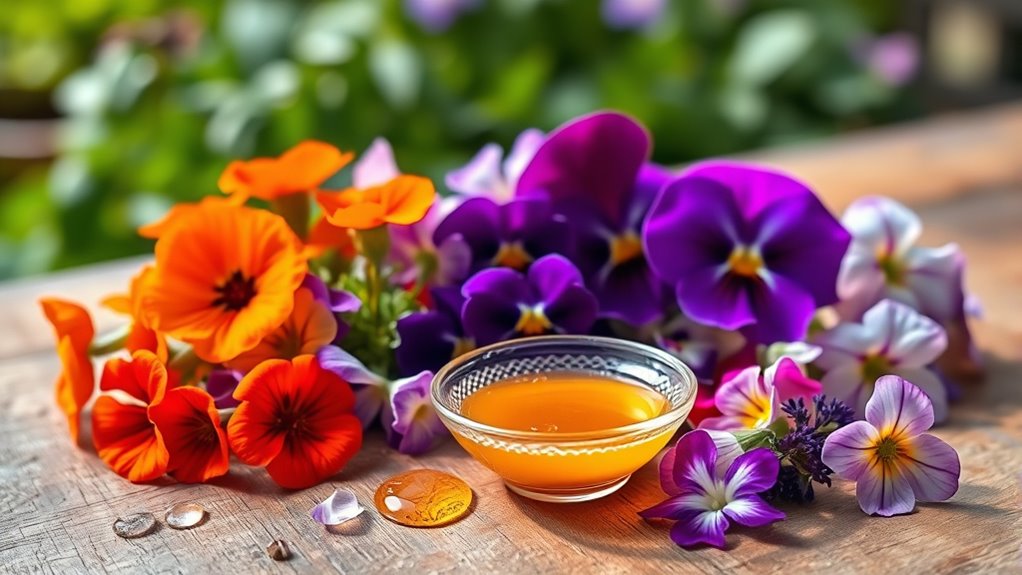
While selecting edible flowers can seem challenging, it’s an enjoyable process that adds a unique touch to your dishes. Start by choosing flowers that are known for being edible, like nasturtiums, pansies, or violets.
Check for freshness; vibrant colors and firm petals indicate quality. You’ll want to avoid flowers from florists or stores that may have been treated with chemicals.
Consider the flavor profile of the flowers you’re selecting. Some add sweetness, while others bring a peppery or herbal note. Think about how they’ll complement your dish.
Finally, keep the season in mind; certain flowers bloom at specific times of the year, so plan accordingly for the freshest options. Happy foraging!
Step 2. Rinse and Pat Dry Flowers
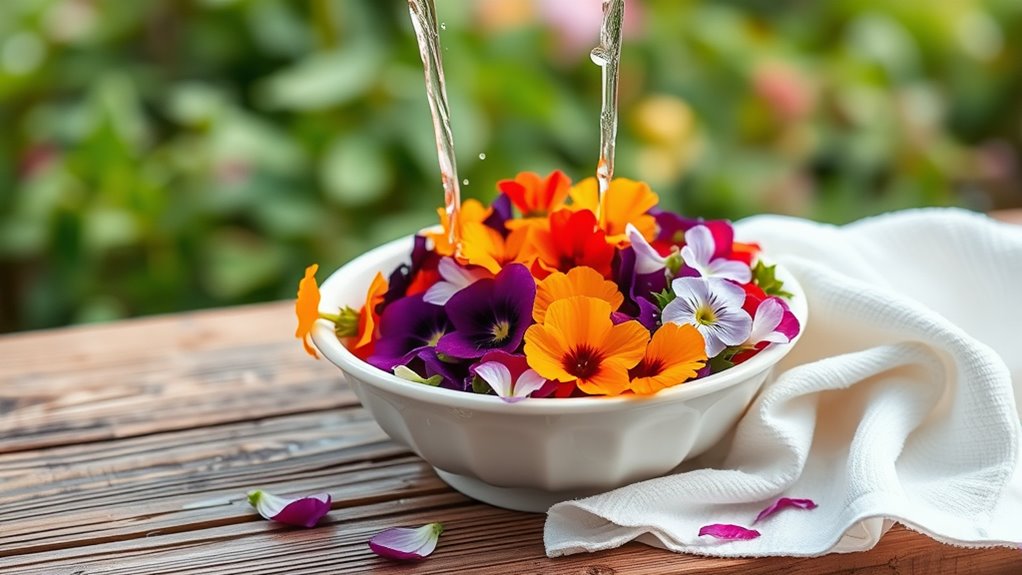
Before you start using your selected flowers, it’s important to rinse and pat them dry to verify they’re clean and ready for your dish.
Begin by filling a bowl with cool water and gently submerging the flowers. Swirl them around to remove any dirt or insects. Avoid harsh scrubbing, as delicate petals can bruise easily.
After rinsing, lift the flowers out and place them on a clean kitchen towel or paper towels. Gently pat them dry, taking care not to crush the petals. This step verifies your edible flowers not only look great but are also safe to eat.
Once dried, you can move on to prepping them for your culinary creations, enhancing both flavor and presentation.
Step 3. Remove Stems and Leaves
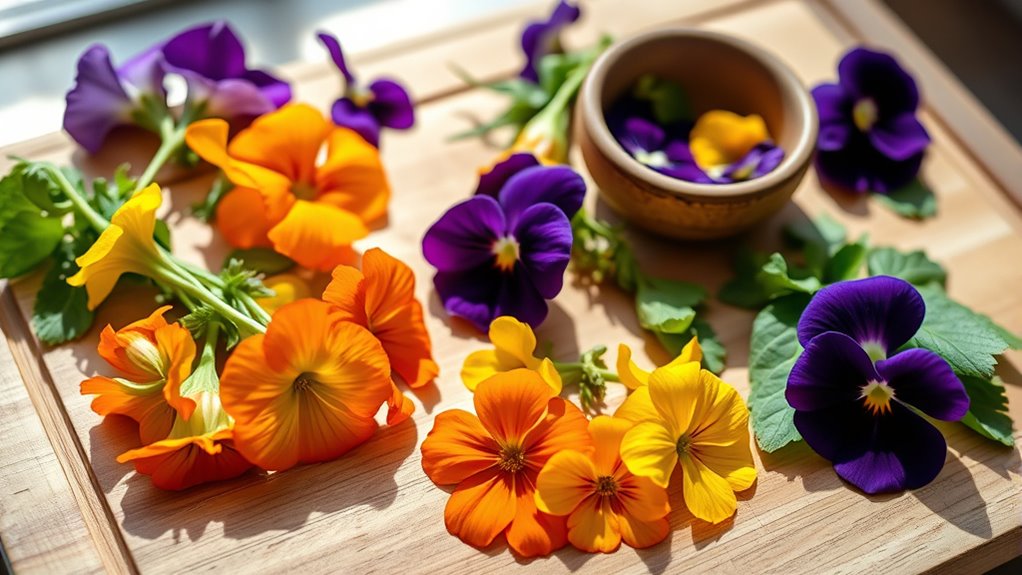
Start by carefully removing the stems and leaves from your edible flowers. This step is essential to guarantee that only the petals are used in your dish.
Hold the flower gently, and with a clean pair of scissors or your fingers, snip off the stem right below the bloom. For larger flowers, you may want to remove any larger leaves that could be tough or bitter.
As you work, check for any blemished or damaged petals, and discard those to maintain the visual appeal of your toppings.
Remember, some flowers have more pronounced flavors than others, so keep that in mind as you prepare.
Once you’ve removed the stems and leaves, you’re ready to use the beautiful petals in your culinary creations!
Step 4. Arrange Flowers Aesthetically
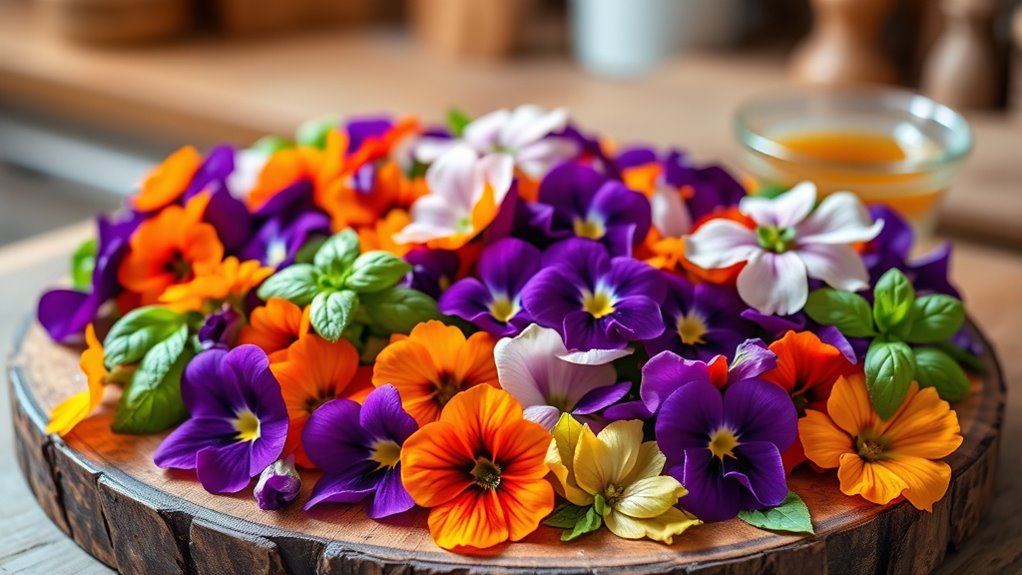
With the petals now ready for use, it’s time to think about how to arrange them beautifully on your dishes. Start by choosing a base color for your dish that complements the flowers; this enhances their visual appeal.
Place larger petals first, creating a focal point, and layer smaller petals around them. Balance is key, so distribute colors evenly and avoid clustering similar hues together.
Consider the height and shape of your dish; a flat plate might benefit from a scattered look, while a tall dessert can handle a more vertical arrangement. Don’t forget to leave some negative space for a cleaner presentation.
Finally, step back to assess your arrangement and adjust as needed for that perfect, eye-catching finish.
Step 5. Garnish With Edible Flowers
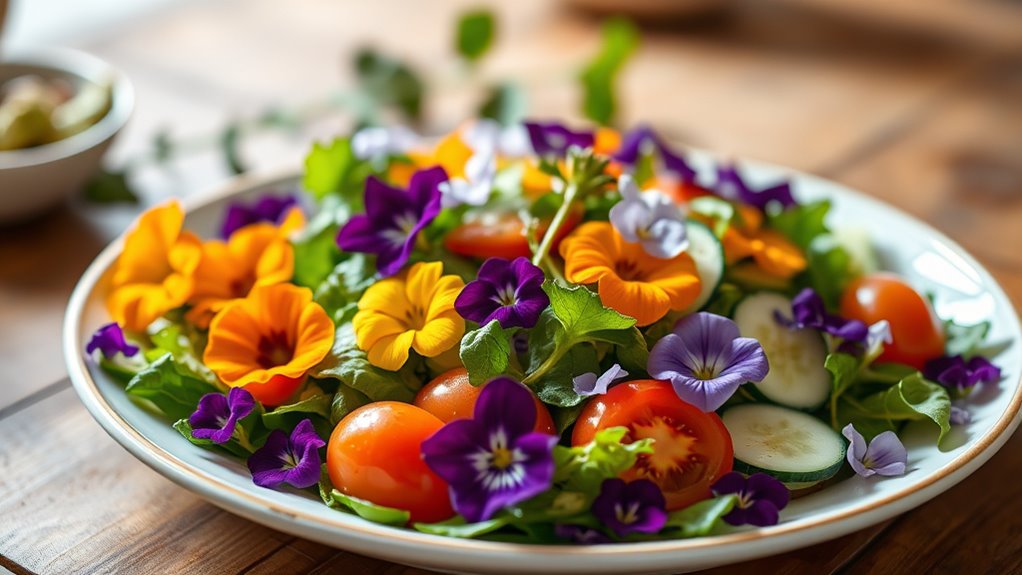
How can you elevate your dish with edible flowers? Start by selecting vibrant, fresh blooms that complement your meal’s flavors. Choose flowers like nasturtiums for a peppery kick or pansies for their sweet taste. Rinse the flowers gently under cold water to remove any dirt or insects, then pat them dry with a paper towel.
Next, consider the placement. Scatter them artfully over your dish or cluster them for a bold pop of color. For a creative twist, use edible flowers to garnish soups, salads, or desserts.
Just remember, less is often more—ensure the flowers don’t overpower your dish. Finally, serve immediately to showcase their beauty and freshness, delighting both the eyes and palate of your guests. Enjoy!
Final Thoughts
As you explore the world of edible flower toppings, you’ll discover not only their visual appeal but also the unique flavors they can bring to your dishes.
These vibrant additions can elevate your meals, turning simple recipes into stunning culinary experiences. Whether you’re enhancing salads, desserts, or drinks, the right flowers can add a revitalizing twist that surprises and delights your guests.
Don’t hesitate to experiment with different varieties, as each flower offers distinct tastes and aromas. Remember to source your flowers from reputable suppliers, ensuring they’re safe for consumption.
Frequently Asked Questions
Are All Edible Flowers Safe for Consumption?
Not all edible flowers are safe for consumption. While many are delightful and harmless, some can be toxic or cause allergic reactions.
It’s essential you research each flower before trying it. Look for reliable sources or consult with experts to guarantee you’re choosing safe options.
Always wash the flowers thoroughly and check for pesticides or chemicals.
Can I Grow My Own Edible Flowers at Home?
Isn’t it delightful to think about cultivating your own blooms? Yes, you can absolutely grow edible flowers at home!
Start with seeds like nasturtiums or pansies, which thrive in containers or gardens. Make certain they get plenty of sunlight and water, and watch them flourish.
With a little patience and care, you’ll enjoy a vibrant display of colors that not only beautify your space but also enhance your culinary creations.
Happy gardening!
How Do I Store Edible Flowers?
To store edible flowers, you’ll want to keep them fresh and vibrant.
Start by gently rinsing and patting them dry.
Place the flowers in an airtight container lined with a damp paper towel, or use a jar filled with water, covering the stems while leaving the blooms above the waterline.
Store them in the refrigerator, away from strong odors.
Use them within a week for the best flavor and appearance.
What Flavors Do Different Edible Flowers Have?
Different edible flowers offer a range of unique flavors.
For instance, nasturtiums have a peppery taste, while violets provide a sweet, floral note.
Lavender gives off a fragrant, calming essence, perfect for desserts.
If you try hibiscus, you’ll experience a tart, cranberry-like flavor.
Chamomile presents a gentle, apple-like sweetness, making it great for teas.
Exploring these flavors can enhance your dishes, adding both visual appeal and delightful taste to your culinary creations.
Are There Any Allergies Associated With Edible Flowers?
Yes, there are potential allergies associated with edible flowers.
Just like any other food, some individuals might be sensitive or allergic to specific flowers. Symptoms can range from mild reactions, like itching or hives, to more severe responses.
It’s essential to do a patch test before consuming new flowers and consult with an allergist if you have a history of food allergies.
Always make certain you’re using flowers from safe, reliable sources.



